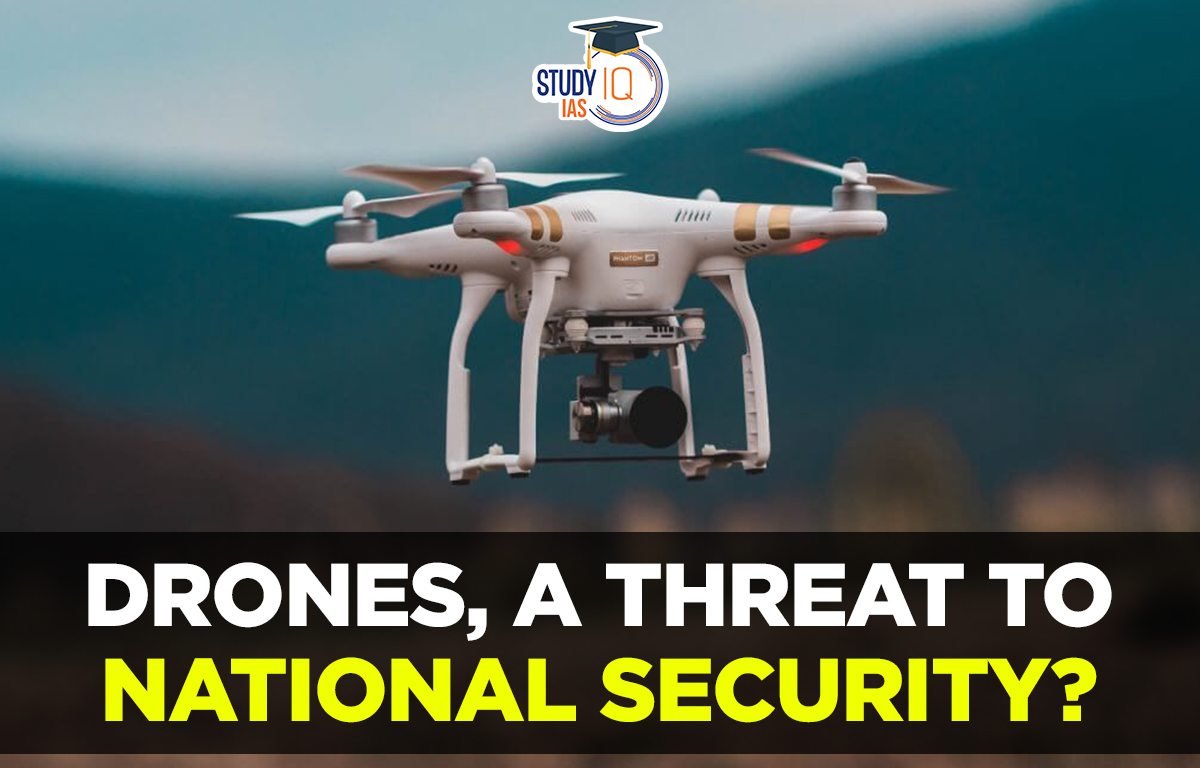Table of Contents
Context: Recently a drone was used to drop bullets and an improvised explosive device (IED) during an attack in Jammu and Kashmir
What are Drones?
- ‘Drone’ is the common name of Unmanned Aerial Vehicle (UAV). It is a flying robot that is either remote or software controlled. Drones are a part of the unmanned aerial system that includes a ground-based controller and a communication system.
- They can be controlled remotely by a human operator or can be programmed to fly autonomously using onboard computers and sensors.
- Drones come in a variety of shapes and sizes, ranging from small, hand-held models to larger, more complex aircraft capable of carrying payloads such as cameras, sensors, and weapons.
- They can be powered by various sources, including electricity, gas, or other fuels, depending on their size and purpose.
Various types of Drones used in Militaries around the World
- Fixed-wing: They are the fastest military UAV currently deployed worldwide. These drones are designed to take off and land like airplanes, using wings instead of rotors for lift.
- Single-rotor: They look similar to helicopters and are more durable than other drones. While they can be more efficient than different types of drones, they require more maintenance.
- Multi-rotor: These drones are the most straightforward option that provides the best control over positioning and framing. Because of this, they are the best choice for surveillance and reconnaissance.

Civil and Commercial Applications of Drones
- In recent times, UAVs have been used extensively for various purposes like film-making, rescue operations, wildfire mapping, crowd monitoring, etc.
- Transport: Drones can carry 2 to 25 kg loads and are used in various activities such as delivering essential goods, supplying medicines to remote locations. They are also utilized by government departments for policing, security, monitoring fires, surveys, and many other activities.
- Photography: Small hobbyist aerial drones are becoming more commonplace and can be used for various day-to-day activities such as aerial photography and the delivery of essential goods.
Drones as an Emerging Threat
- The potential use of drones in a terrorist incident or attack against a critical infrastructure and soft targets is a growing concern for law enforcement agencies worldwide as the availability of drone technology becomes more widespread globally
- For example on April 20, a drone attack was carried out in the Poonch-Rajouri sector of Jammu and Kashmir.
- The attack was meticulously planned, and a drone was used to drop bullets and an improvised explosive device (IED) for the attack.
How do Drones Attack?
- Drone attack is like any military equipment. Weaponized drones are preferred over cruise missiles because they are cheaper, accurate and highly maneuverable.
- It requires good target intelligence, accurate target coordinates, and pictures of the desired impact point.
- A drone can be programmed for an independent attack and could fly into the target and explode. Alternatively, the operative could fly the drone using a remote link.
National Security Threats
- Undetectability: Generally, radar is used to detect aerial vehicles such as airplanes, emitting radio frequency waves in short pulses. However, tiny drones such as nano drones have a small radar cross-section (RCS) which makes them difficult to detect.
- Sizes: Drones come in miniature sizes, making them difficult to shoot down, even if identified. While shooting down a drone that has live transmission capabilities is not useful as the data has already been received by the controller,
- Identification of Origin: Even if a drone is detected and incapacitated, there is no way to identify who sent it.
- Operational Flexibility: Drones are cheaper, safer, and more efficient than conventional methods of espionage. Drones are unmanned, which eliminates the potential threat to people on the operating side.
- Large Borders: Borders pose a challenge in terms of avoiding drone attacks, which can carry out harmful activities such as smuggling of arms and destruction of security apparatus.
- Loopholes in the Laws: There are loopholes in the drone legislation concerning implementation, training, and cost. These loopholes worsen the threat of drone attacks.
- Easy availability: Drones can be used for espionage, terror sponsoring, and destruction of critical infrastructure. The easy availability of advanced technology makes this threat particularly concerning.
Drone Attacks in India
- On June 27, 2021, India experienced its first drone attack at Air Force Station Jammu.
- The attack was carried out by two low-flying drones carrying Improvised Explosive Devices (IEDs).
- Drone spotting has been frequent in India since August 2019, when a drone was found crashed in a village near Amritsar, Punjab.
- Over 150 drone sightings have been recorded so far along the Pakistan border.
Drone Policy and Regulation
- The Drone Rules, 2021 were released by India’s Ministry of Civil Aviation last year.
- More recently they have made major changes to drone laws, and the government has passed Drone (Amendment) Rules, 2022.
- The certification requirement has been spelt out. The drones must have a unique identification number, and be registered like we register arms.
- National Counter Rogue Drone Guidelines 2019 provide measures to prevent the misuse of drones; for example, it states the importance of drone detection and neutralization. It also discusses the limitations of the present drone response.
- Unmanned Aircraft Systems Rules 2021(National Drone Policy 2.0): In addition to the categorization of drones in the National Drone Policy 1.0, these Rules further categorize Unmanned Aircraft Systems into- Airplane, Rotorcraft, Autonomous Aircraft Systems, etc.

Way Forward
- Three-step approach to counter drone threats: The three-step approach involves detecting, identifying, and neutralizing any airborne drone threats.
- Drones that cross the country’s border must be treated as hostile. All other drones should be managed through a drone policy, licensing, and regulations.
- Investing in Anti-Drone Technology: The Indian government must take the lead in investing in anti-drone technology.
- This includes allocating a budget to incentivize stakeholders to focus on anti-drone technology development.
- Immediate Areas of Focus: While countering drone attacks across all of India is necessary, it is currently not possible. The government should identify areas of core importance, such as air bases and VIP areas in cities, and focus on creating awareness and developing drone defenses within these areas.
- Developing Counter-Drone Technology: India needs to invest in its own Unmanned Aerial Vehicle (UAV) systems and counter-drone technology to detect and track threats, especially around critical assets.


 Daily Quiz 18 April 2025
Daily Quiz 18 April 2025
 OSSC CGL Syllabus 2025 and Exam Pattern ...
OSSC CGL Syllabus 2025 and Exam Pattern ...
 AI and its Regulation in India, Limitati...
AI and its Regulation in India, Limitati...





















